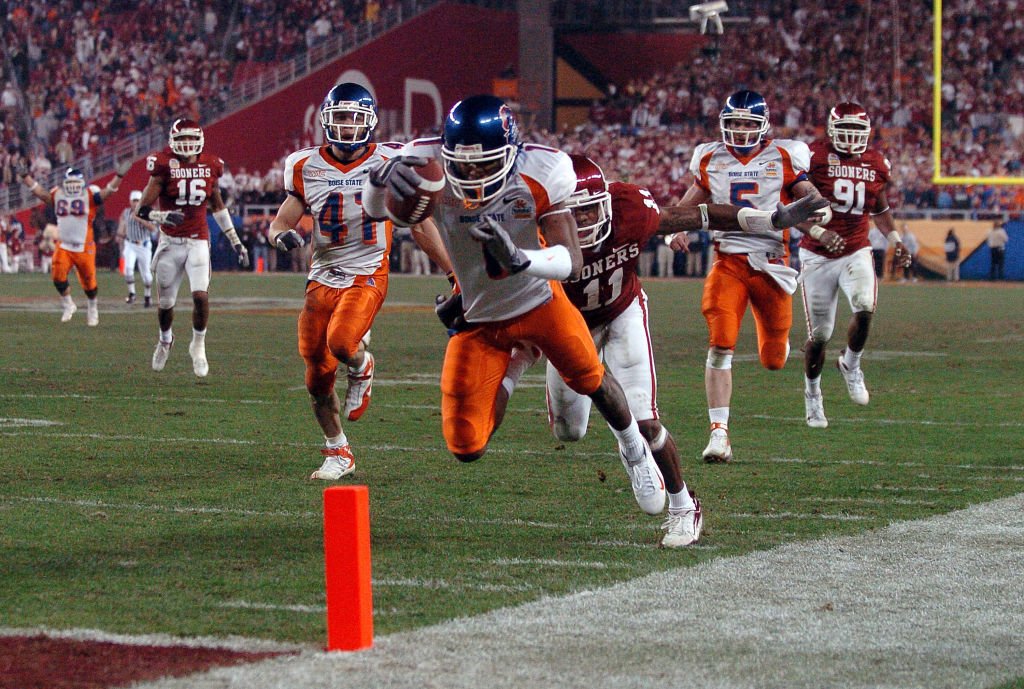
Once again, it is time for the Defector staff to go into seclusion for our annual company meetings and fall frolic. This year we are gathering in Atlantic City, America’s abandoned playground. We decided to hold a mini theme week to keep the site robust and full of blogs while we’re in meetings. This year’s theme: Risk!
The total number of “great games” that you witness as a sports fan can only increase. But in the growing mental pile of walk-offs, Hail Marys, buzzer-beaters, and triple overtimes, I believe that there is a solid, unchanging foundation of formative instant-classics—games that literally shaped your concept of what sports drama should be. In the same way that, per Sam Sifton, a person’s first source of pizza becomes the standard against which they judge all pizza for the rest of their lives, the first time you find yourself dazzled by a seemingly impossible outcome remains a permanent reference point. When I trouble myself for a list of “great games,” the memories that immediately surface aren’t fresh experiences but set impressions from a decade ago or longer. I think about David Freese’s Game 6 in 2011, or Landon Donovan’s goal against Algeria, or Trey Burke’s shot against Kansas, or Boise State beating Oklahoma with a bag of tricks in the Fiesta Bowl.
The matchup story of this particular bowl from New Year’s Day 2007 is easy to parse even if you have only a passing familiarity with college football. Oklahoma was Oklahoma, one of the defining programs of the sport. Boise State was … what even was this team? While the aftermath of this night turned the school into a household name, Boise State once sounded like a middle-of-nowhere schedule filler, notable just for the gimmicky blue turf that an anchor might crack a joke about during a 15-second highlight package on Sunday morning. Yes, they’d recently become a force in the WAC, but this was before the landscape-shifting explosion of accessibility that allowed fans to watch basically any game they wanted, any time they wanted. For most of the country, the WAC was invisible, mostly relegated to local TV or appearing on ESPN for weird non-Saturday dates—when “serious” college football didn’t happen. Before this Fiesta Bowl, Boise State had never played a January bowl game before. Their most recent postseason contest, the 2005 MPC Computers Bowl, saw them lose to Boston College on their own blue turf.
But Boise State didn’t achieve greatness in the span of one night. After joining Division I-A in 1996 and making some minor waves under Houston Nutt with a drought-breaking win at Idaho and a near-upset over Wisconsin, the school built a strong coaching infrastructure that began with future NFL coach Dirk Koetter. As the program ascended to WAC dominance, the coaches changed, each time replaced with an offensive coordinator ready to bring the program to a new level. Chris Petersen took the reins from Dan Hawkins in 2006 and led the Broncos to the undefeated season that earned them the date with Oklahoma. Even if they didn’t have a primetime reputation, Boise State had quickly grown into the biggest fish in their own little pond.
Oklahoma, meanwhile, was forever a monster. National champs under Bob Stoops in 2000, then runners-up in 2003 and 2004, the Sooners took a slight dip in the 2005 season but gained momentum in the 2006 season despite an injury to superstar running back Adrian Peterson and the dismissal of QB Rhett Bomar for the sin of receiving money from a booster. While Boise State entered New Year’s Day without a single win over a ranked team on its résumé, Oklahoma’s eight-game win streak included triumphs over Missouri, Texas A&M, and Nebraska in the Big 12 title game. They’d proven themselves in opportunities that the Broncos had never been able to reach.
Everything about the game itself has been overshadowed by a few plays, but it was pretty wild the whole way through. An Oklahoma fumble near their own end zone helped Boise State get out to a 14-0 lead. A long, slippery run by Drisan James after catching a cross-the-field pass from Jared Zabransky added a touchdown with just 33 seconds remaining to make it 21-10 at half. A Boise State punt in the third was redeemed after OU’s Paul Thompson threw a pick-six on the next drive, extending the Broncos’ lead to 18. But their luck reversed on a botched punt return that set up an easy Oklahoma score. The Sooners defense kept Boise State in check until the favorites finally earned a tying touchdown and two-point conversion that left 1:26 on the clock. Zabransky immediately threw an interception, a total miscommunication with his wideout that resulted in a Sooner touchdown. Oklahoma was in the lead, 35-28, with less than a minute to play.
It didn’t take long to find redemption. A long Zabransky pass put the Broncos on midfield with time running down, but a sack and two incompletions set up a do-or-die play at the end. Zabransky dropped back and found James in front of the Oklahoma defense. As five Sooners closed in, he flipped the ball to Jerard Rabb, who was running across the field in the opposite direction. Rabb had a step on every Sooner and made it to the end zone.
This was an unbelievable bit of backyard football that would go on to fuel one of sport’s most enduring debates: Is it called a “hook-and-ladder,” or a “hook-and-lateral?” Watching this again, I think in the spirit of the play you have to take the fun name over the one that technically makes sense.
In overtime, Adrian Peterson—in his return from injury—tried to snuff out the underdog energy with an instant touchdown. Down seven, Boise State took tentative steps toward the goal line until they faced another must-convert—fourth-and-2 at the six. This time, they didn’t turn to Zabransky. In another moment of misdirection, they motioned their QB out wide and sent the snap to wide receiver Vinny Perretta, who rolled out and lofted a pass over a cloud of dust to Derek Schouman for six.
A kick could have tied the game and brought a second overtime, where maybe the Broncos could hope for another Sooners miscue. But Chris Petersen was feeling hot and ready to celebrate. Boise State went for two and the win, and again they dusted off a rarity. In a trips formation with running back Ian Johnson on his six, Zabransky faked a quick screen to the right, then snuck the ball behind his back to Johnson. The three blockers in orange and white sealed off three Oklahoma players with any shot at making the tackle, and Johnson galloped into the end zone. He cemented his football immortality moments later after he dropped to one knee and proposed to his cheerleader girlfriend, Chrissy Popadics, on live TV.
The funny part about how I revere this game is that I didn’t actually watch it. This all happened long past my bedtime. I was 11, and while I would have watched the USC-Michigan Rose Bowl earlier in the day, these events escaped my awareness until the following morning when I had to catch up with SportsCenter. I learned that Boise State won, which didn’t make a lot of sense. I learned that they did so with some ridiculous play calls, beyond what I could have imagined. I learned what a hook-and-ladder was and how you run a Statue of Liberty play. I learned the names of the quarterback and running back and never forgot them. I watched the replays multiple times while people on TV talked about the game, and I think I was mostly just stunned by the unexpected, in a way that doesn’t happen to me anymore.
Boise State beating Oklahoma was like a surprise that changed a whole pack of assumptions in my kid brain—that big teams beat little teams, that weird gimmick plays were just for after practice, that going for two was not a risk worth taking. Because of this Fiesta Bowl, I’ll always be a little more prepared for any and all future upsets.







